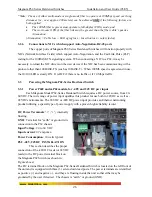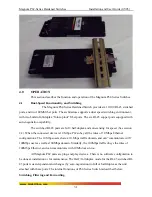
Magnum P62-Series Hardened Switches Installation and User Guide (05/05)
24
www GarrettCom com
.
.
1. Using standard twisted pair media, insert either end of the cable with a RJ-45 plug into
the RJ-45 connector of the port. Note that, even though the connector is shielded, either
unshielded or shielded cables and wiring may be used.
2. Connect the other end of the cable to the corresponding device.
3.
Use the LINK LED to ensure proper connectivity by noting that the LED will be
illuminated when the unit is powered and proper connection is established. If this does not
help, ensure that the cable is connected properly and that the device on the other end is
powered and is not defective.
4.
For Port # 1 or 1SW, if the LINK LED is not illuminated, move the switch which has a
cross-over or up-link for linking to another hub or Switch.
NOTE: for Power Substations: In support of the IEEE 1613 Class 2 standard, GCI advises
that, for substation applications, the RJ-45 ports are intended for connectivity to other
communication equipment such as routers or telecommunication multiplexers installed
in close proximity (i.e., less than 2 meters or 6.5ft) to the (m)P62(F). It is not
recommended to use these ports in substation applications to interface to field devices
across distances which could produce kigh (greater than 2500V ) levels of ground
potential rise (GPR) during line-to-ground fault conditions. The (m)P62(F) passes the
1613specifications for zero packet loss with fiber ports & with RJ45 ports used as
indicated here.
3.2.2
Connecting Fiber Optic SC-type, "Snap-In"
The following procedure applies to installations using SC-type fiber connectors. This
procedure applies to ports using multi-mode SC fiber connectors.
1.
Before connecting the fiber optic cable, remove the protective dust cap / plug from the end
of the fiber connectors, exposing the ports opening. Save the dust cover / plug for future
use, in case the fiber cable needs to be unplugged for service.
2.
Wipe clean the ends of the dual connectors with a soft cloth or lint-free lens tissue
dampened in alcohol. Make certain the connectors are clean before connecting. Then,
insert the square male connector into the SC female jack of the Fiber port connector until
it clicks and secures.
Note:
One strand of the duplex fiber optic cable may be coded using color bands
at regular intervals; you should use the color-coded strand on the associated ports at
each end of the fiber optic cable segment.
3.
Connect the Transmit (TX) port on the Magnum Fiber port to the Receive (RX) port of the
remote device. Begin with the color-coded strand of the cable for this first TX-to-RX
connection. Note – the two male square-end SC cable strands may be fastened together to
plug as a unit.
4.
Connect the Receive (RX) port to the Transmit (TX) port of the remote device. Use the
non-color coded fiber strand for this.
5.
The LINK LED for the fiber connector will illuminate when a proper connection has been
established at both ends (and when power is ON in the unit). If LINK is not lit after cable
connection, the normal cause is improper cable polarity. Swap the fiber cables at the fiber
connector to remedy this situation.
3.2.3
Connecting Fiber Optic ST-type, “Snap-In” (Optional)
The following procedure applies to installations using ST-type fiber connectors, i.e., using



























